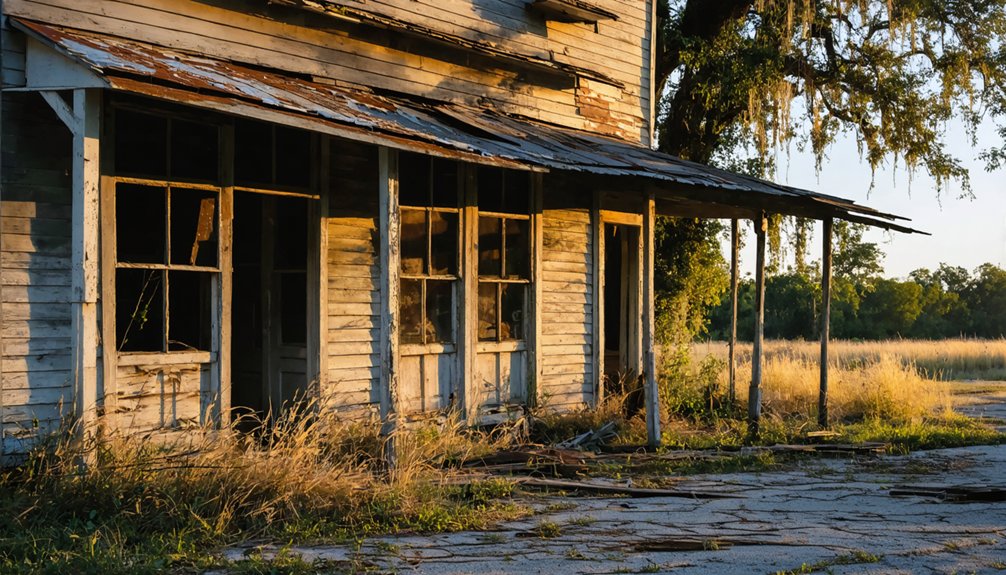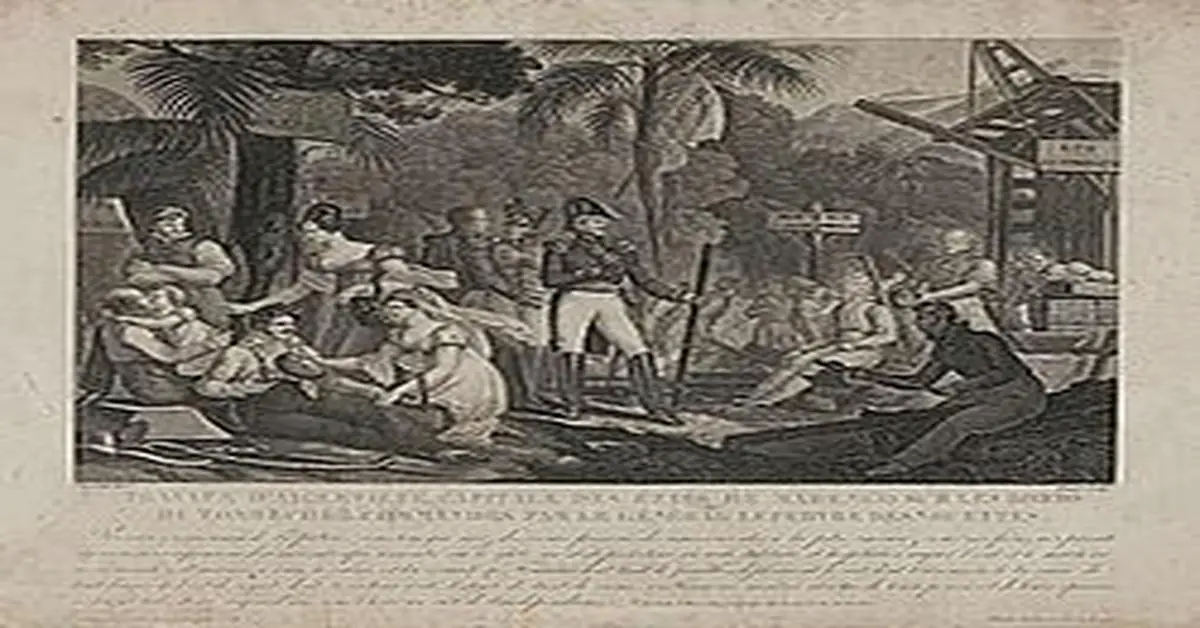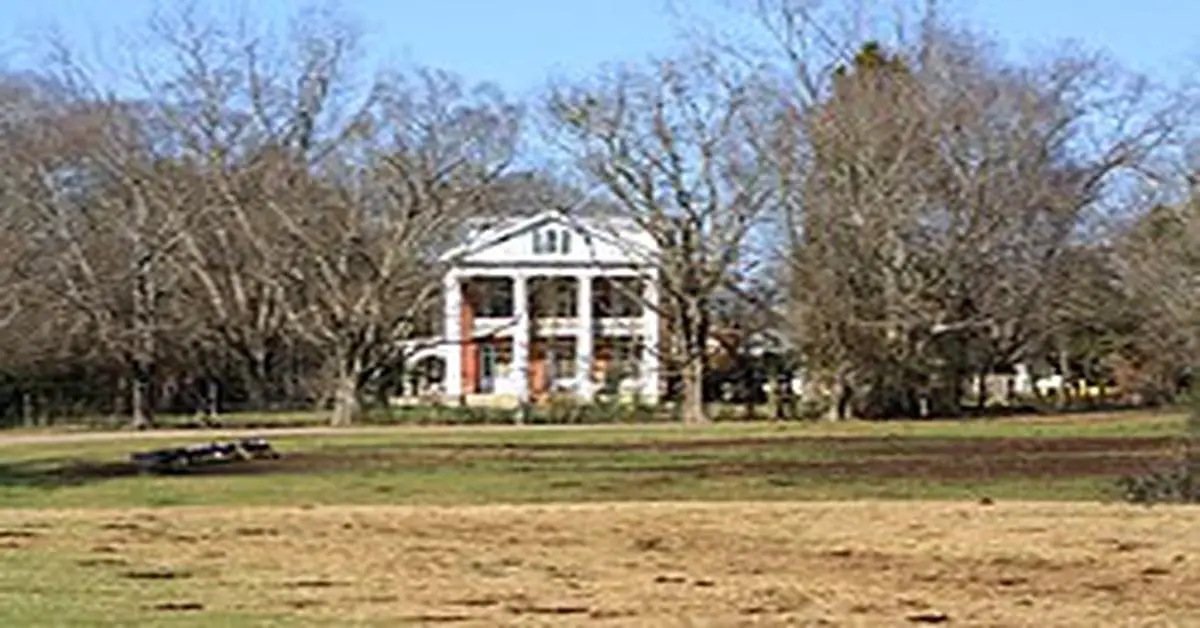You’ll find Prairie Bluff perched on a high chalk bluff overlooking the Alabama River in Wilcox County. This once-bustling river port began in the late 1790s when Samuel Mims established a ferry crossing, growing into a crucial trading hub by 1819. Notable families like the Sherrods and Saunders transformed it into a prosperous settlement until the Civil War triggered its decline. Today, only weathered gravestones in Prairie Bluff Cemetery whisper stories of its former glory.
Key Takeaways
- Prairie Bluff was a thriving Alabama river port established in the late 1790s that declined into abandonment after the Civil War.
- The town’s economy centered on river commerce and cotton trade until railroads bypassed the area, leading to its isolation.
- Construction of Millers Ferry Lock and Dam in 1963 further altered the landscape, contributing to Prairie Bluff’s ghost town status.
- Only the Prairie Bluff Cemetery remains, containing weathered graves from the 1830s through 1860s at coordinates 32°08′04″N 87°24′13″W.
- The site transformed from a bustling steamboat stop with taverns and trading posts into an abandoned settlement atop a chalk bluff.
The Rise of a River Trading Hub (1819-1861)
When Samuel Mims established a ferry near Prairie Bluff in the late 1790s, he laid the groundwork for what would become an essential river trading hub along the Alabama River.
By 1819, as Wilcox County formed, settlers from Virginia and the Carolinas flocked to this strategic location, drawn by its commanding position atop a high bluff perfect for river transportation.
Prairie Bluff’s elevated perch drew settlers from across the Southeast, who recognized its strategic value for controlling river commerce.
You’d find Prairie Bluff’s docks bustling with flatboats and steamboats, connecting the town to Mobile and Montgomery through extensive trade networks.
Local planters exported their agricultural products while merchants received manufactured goods from distant ports.
The town’s economy thrived on this river commerce, with taverns and trading posts serving the steady flow of traders and travelers.
Even Andrew Jackson recognized the location’s potential, investing in local plantations to capitalize on the flourishing river trade.
Notable Figures Who Shaped Prairie Bluff
Prairie Bluff’s early development was shaped by influential families who established deep roots in the community from 1816 onwards. Joseph Gee, the first white settler from North Carolina, laid the foundation by establishing a prosperous plantation. Notable families like the Sherrods, Sikes, Saunders, Gilchrists, and Dunns soon followed, bringing their Virginia and Tennessee heritage to shape the town’s social fabric.
Among the community leaders, Rev. Turner Saunders exemplified the strong Methodist influence that bound these families together. Like many settlements along the Alabama River, Prairie Bluff attracted wealthy settlers from Virginia and the Carolinas who transformed the wilderness into thriving communities. The importance of preserving these family histories led to establishing genealogical libraries throughout the region.
You’ll find Prairie Bluff’s impact extended well beyond Alabama through figures like William H. Gaston, who became Dallas’s prominent banker, and William Q. Atwood, who transformed into a lumber baron in Michigan.
The Dailey family represented the African American community’s enduring legacy, with members like Ervin Delmo Dailey serving in World War II.
Economic Forces Behind the Town’s Decline
As Alabama’s river commerce flourished in the mid-1800s, Prairie Bluff’s strategic location along the Alabama River initially fueled its prosperity through cotton trade and agriculture.
However, you’ll find the Civil War marked the beginning of the town’s economic downturn, as trade embargoes and military conflicts disrupted essential river commerce. The town’s presence was first marked on maps in 1819, showing its early significance as a river settlement.
The most devastating blow came from transportation shifts in the post-war era. When railroad companies bypassed Prairie Bluff in favor of new routes, you’d see how quickly the town lost its competitive edge.
Without rail access, businesses couldn’t effectively transport goods to market, and the once-bustling river port became increasingly isolated. The construction of Millers Ferry Lock and Dam in 1963 sealed the town’s fate, permanently altering the landscape that had once supported its thriving economy.
Geological Heritage and Natural Features
Deep beneath Prairie Bluff’s abandoned townsite lies a remarkable Late Cretaceous chalk formation that spans up to 110 feet in thickness.
You’ll find this white to bluish-gray geological significance exposed across south-central Alabama, extending into Mississippi in a distinctive arc pattern. The chalk preserves an ancient marine world from the Maastrichtian stage, where countless microscopic creatures once thrived.
Spanning across Alabama into Mississippi, this ancient chalk formation captures a microscopic marine ecosystem from Earth’s distant past.
Scientists have uncovered extraordinary fossil discoveries here, including 82 species of ostracoda, with 30 previously unknown to science.
Situated atop a cliff, the formation overlooks the winding Alabama River where it has remained a prominent geographical landmark for centuries.
The formation also bears witness to the dramatic end of the Cretaceous period, with evidence of the Chicxulub meteor impact preserved in its layers. This significant layer is part of the broader Selma Group rocks that mark the final chapter of the Cretaceous in Alabama.
You can spot signs of ancient tsunamis and earthquakes in the rock, frozen in time as spherule-bearing sandstones and distinctive fault patterns.
What Remains Today: Cemetery and Historical Legacy
Standing as the sole physical remnant of a once-thriving river town, the Prairie Bluff Cemetery contains weathered graves dating from the 1830s through the 1860s.
Today, you’ll find this hidden piece of history at coordinates 32°08′04″N 87°24′13″W, though it’s not easily visible from nearby roads. Local awareness of this historical site has faded, with even the original road names changed as modern subdivisions have taken over the landscape. Many of the broken tombstones lie partially buried beneath layers of sand.
The town’s position on a high bluff overlooking the Alabama River once made it a vital stop between Cahaba and St. Stephens.
- No historical markers identify the cemetery’s significance
- Cemetery preservation efforts appear minimal, with limited documentation of grave conditions
- The site sits at 141 feet elevation, unmarked and largely forgotten
- Nearby Prairie Mission school, while historically listed, has no direct connection to Prairie Bluff
The cemetery stands as a silent witness to Prairie Bluff’s evolution from bustling port to vanished community.
Frequently Asked Questions
What Happened to Prairie Bluff During the Civil War?
You’ll find your once-prosperous river haven weathered the Civil War intact, but freedom’s price meant lost commerce, as disrupted trade and declining river shipments dealt crushing economic blows to your Alabama port.
Were There Any Documented Paranormal Activities in Prairie Bluff Cemetery?
You won’t find official records of ghost sightings at Prairie Bluff cemetery, though local cemetery legends exist. Nearby Alabama graveyards report paranormal activity, but Prairie Bluff’s haunted claims remain largely unverified.
What Native American Tribes Originally Inhabited the Prairie Bluff Area?
You’ll find the Creek Nation was predominant in Prairie Bluff’s ancestral lands, with notable Choctaw influence in the surrounding territories. These proud peoples called this river-blessed region home until the 1830s.
How Many People Lived in Prairie Bluff During Its Peak?
You can’t know Prairie Bluff’s exact peak population since historical records don’t specify town numbers, though population trends suggest its greatest size came during 1840-1860’s period of commercial historical significance.
What Were the Major Diseases and Epidemics Affecting Prairie Bluff?
You’d have faced devastating disease outbreaks including the 1873 cholera epidemic and 1918-1919 influenza pandemic, plus ongoing health impacts from typhoid fever, tuberculosis, malaria, and diphtheria near the river.
References
- http://history-sites.com/cgi-bin/bbs62x/alcwmb/webbbs_config.pl?md=read;id=33524
- https://www.onlyinyourstate.com/experiences/alabama/alabama-ghost-towns
- https://deepsouthurbex.com/2020/01/02/6-south-alabama-ghost-towns/
- https://digitalalabama.com/alabama-ghost-towns/alabama-ghost-towns/9449
- https://en.wikipedia.org/wiki/Prairie_Bluff
- https://www.blueridgeoutdoors.com/go-outside/ghost-towns-of-old-cahawba/
- http://leepeacock2010.blogspot.com/2015/07/prairie-mission-historical-marker.html
- https://apps.dtic.mil/sti/tr/pdf/ADA117065.pdf
- https://www.prairiebluff.com/category/history/
- https://trace.tennessee.edu/cgi/viewcontent.cgi?article=6869&context=utk_graddiss


